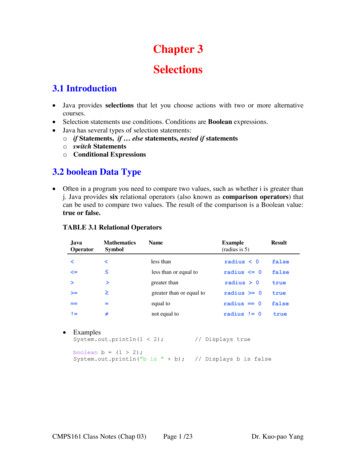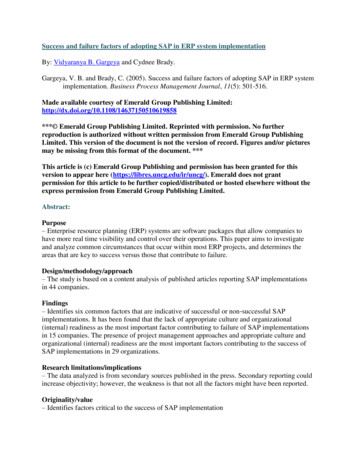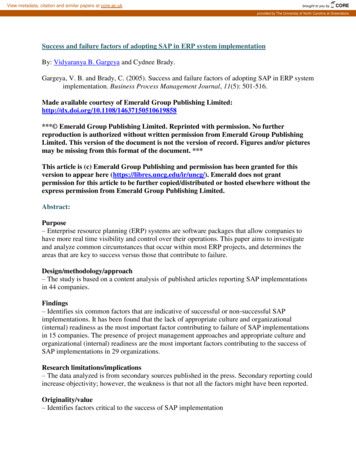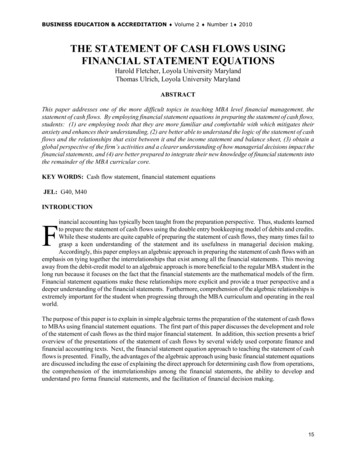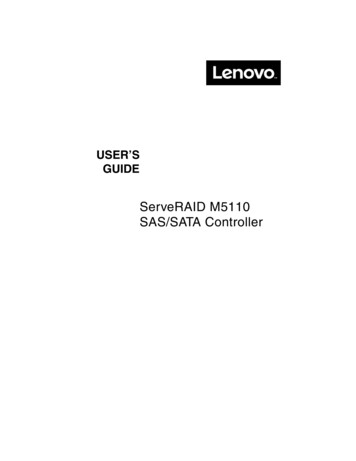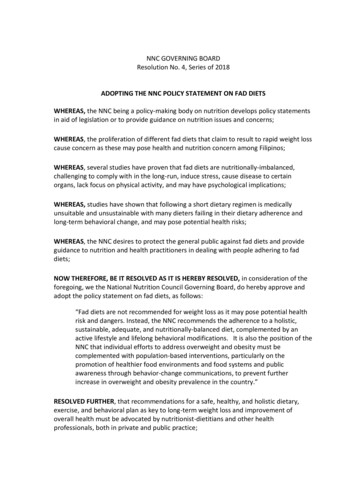
Transcription
NNC GOVERNING BOARDResolution No. 4, Series of 2018ADOPTING THE NNC POLICY STATEMENT ON FAD DIETSWHEREAS, the NNC being a policy-making body on nutrition develops policy statementsin aid of legislation or to provide guidance on nutrition issues and concerns;WHEREAS, the proliferation of different fad diets that claim to result to rapid weight losscause concern as these may pose health and nutrition concern among Filipinos;WHEREAS, several studies have proven that fad diets are nutritionally-imbalanced,challenging to comply with in the long-run, induce stress, cause disease to certainorgans, lack focus on physical activity, and may have psychological implications;WHEREAS, studies have shown that following a short dietary regimen is medicallyunsuitable and unsustainable with many dieters failing in their dietary adherence andlong-term behavioral change, and may pose potential health risks;WHEREAS, the NNC desires to protect the general public against fad diets and provideguidance to nutrition and health practitioners in dealing with people adhering to faddiets;NOW THEREFORE, BE IT RESOLVED AS IT IS HEREBY RESOLVED, in consideration of theforegoing, we the National Nutrition Council Governing Board, do hereby approve andadopt the policy statement on fad diets, as follows:“Fad diets are not recommended for weight loss as it may pose potential healthrisk and dangers. Instead, the NNC recommends the adherence to a holistic,sustainable, adequate, and nutritionally-balanced diet, complemented by anactive lifestyle and lifelong behavioral modifications. It is also the position of theNNC that individual efforts to address overweight and obesity must becomplemented with population-based interventions, particularly on thepromotion of healthier food environments and food systems and publicawareness through behavior-change communications, to prevent furtherincrease in overweight and obesity prevalence in the country.”RESOLVED FURTHER, that recommendations for a safe, healthy, and holistic dietary,exercise, and behavioral plan as key to long-term weight loss and improvement ofoverall health must be advocated by nutritionist-dietitians and other healthprofessionals, both in private and public practice;
NNC GOVERNING BOARDResolution No. 4, Series of 2018ADOPTING THE NNC POLICY STATEMENT ON FAD DIETSRESOLVED FURTHER, for the National Nutrition Council Secretariat to ensure that thispolicy statement is disseminated as widely as possible to the general public,practitioners and health and nutrition workers and those in the medical and alliedprofessions; and its dissemination monitored and reported to the Governing Board.Approved this 21st day of June 2018.FRANCISCO T. DUQUE III, MD, MScSecretary of Health and ChairpersonNational Nutrition Council Governing BoardAttested:Assistant Secretary Maria-Bernardita T. Flores, CESO IICouncil Secretary and Executive Director IVNational Nutrition Council
NNC GOVERNING BOARDResolution No. 4, Series of 2018ADOPTING THE NNC POLICY STATEMENT ON FAD DIETSCONFORME:EMMANUEL F. PIÑOLSecretary of AgricultureVice-Chairperson, NNC Governing BoardEDUARDO M. AÑOSecretary of the Interior and Local GovernmentVice-Chairperson, NNC Governing BoardBENJAMIN E. DIOKNOSecretary of Budget and ManagementMember, NNC Governing BoardLEONOR M. BRIONESSecretary of EducationMember, NNC Governing BoardSILVESTRE H. BELLO IIISecretary of Labor and EmploymentMember, NNC Governing BoardFORTUNATO T. DELA PEÑASecretary of Science and TechnologyMember, NNC Governing BoardVIRGINIA N. OROGOActing Secretary of Social Welfare andDevelopmentMember, NNC Governing BoardERNESTO M. PERNIASecretary of Socio-Economic PlanningDirector-GeneralMember, NNC Governing BoardRAMON M. LOPEZSecretary of Trade and IndustryMember, NNC Governing BoardDR. AMADO R. PARAWANPrivate Sector RepresentativePhilippine Coalition of Advocates for NutritionSecurity, Inc.Member, NNC Governing BoardROMEO C. DONGETOExecutive Director, Philippine Legislators’Committee on Population and DevelopmentMember, NNC Governing Board
Republic of the PhilippinesDepartment of HealthNATIONAL NUTRITION COUNCILNATIONAL NUTRITION COUNCILPOLICY STATEMENT ON FAD DIETSI.IntroductionThe National Nutrition Council (NNC) is the highest policy-making andcoordinating body on nutrition in the country. It formulates and coordinates thePhilippine Plan of Action for Nutrition (PPAN) as the country’s framework fornutrition improvement. Along with this mandate, the NNC issues policystatements in aid of legislation or to clarify prevailing issues in nutrition anddefine the stand of the NNC in addressing such issues.One issue that has been identified by the NNC is the proliferation of fad dietswhich may pose health and nutrition risks to the individuals who patronize thesediets. Therefore, there is a need to have a policy statement addressed towardsthe general public, health and nutrition workers and practitioners to serve as areference in dealing with fad diets.The policy statement on fad diets is developed in consultation with doctors,experts, and professionals in the field of weight loss and diet management. Thispolicy statement is based on the review of numerous peer-reviewed literatureand reference materials on obesity, weight loss, and weight management.II.NNC Policy Statement on Fad DietsThe policy of the NNC is that - Fad diets are not recommended for weight loss asit may pose potential health risk and dangers. Instead, the NNC recommends theadherence to a holistic, sustainable, adequate, and nutritionally-balanced diet,complemented by an active lifestyle and lifelong behavioral modifications. It isalso the position of the NNC that individual efforts to address overweight andobesity must be complemented with population-based interventions, particularlyon the promotion of healthier food environments and food systems and publicawareness through behavior-change communications, to prevent the furtherincrease in overweight and obesity in the country.
NATIONAL NUTRITION COUNCILPOLICY STATEMENT ON FAD DIETSIII.Definition of Fad DietsA fad diet, also known as a crash diet or diet cult, is any dietary regimen orpractice promoted for weight loss and improvement of health that does not formpart of standard dietetic-led weight management advice.1 It comprises a veryrestrictive eating plan with few or an unusual combination of foods for a briefperiod of time and often makes claims for quick drastic weight loss.2The characteristics of fad diet are as follows: IV.Makes dramatic claims that are not supported by evidence or seem “toogood to be true”Is nutritionally imbalancedPromises rapid weight loss (more than 1 kilogram in a week)Does not include or encourage improvement of health and exerciseProvides no health warning to those with pre-existing medical conditionsBased on anecdotal evidence and/or testimonials rather than robust clinicaltrials and/or simplistic conclusions drawn from complex studiesFocuses on appearance-related outcomes rather than health benefitsRestricts several foods and/or whole food groupsRecommends consumption of large amounts of one food or food typeSuggests that food should be eaten in a specific order or specificcombinationsSuggests that certain foods or ingredients “burn” fatRequires purchase of specific products, supplements or resources.Fad Diets through the yearsFad diets have been around for almost 200 years when the Vinegar and WaterDiet was made popular by Lord Byron where one eats only potatoes drenched invinegar. This was followed in 1825 when a low-carbohydrate regimen waspublished in “The Physiology of Taste” by Jean Brillat-Savarin. Grahams Dietconsisting of the crackers was introduced in 1830 and in 1863, Banting’s LowCarbohydrate Diet which made Banting synonymous with dieting at that time.Below is the list of fad diets through the years although not exhaustive.1.2.3.4.1903 - Horace Fletcher promotes “Fletcherizing” (chew food 32 times)1917 – Calorie Counting by Lulu Hunt Peters1925 – Cigarette Diet (have cigarette instead of a sweet)1928 – Inuit Meat-and-Fat Diet (caribou, raw fish and whale blubber)1Hankey, C. (2018). Advanced nutrition and dietetics in obesity. Hoboken, NJ: Wiley.British Dietetic Association. Fad diets, 2006. Available online at:https://www.bda.uk.com/foodfacts/faddiets.pdf, accessed 22 March 2018.25
NATIONAL NUTRITION COUNCILPOLICY STATEMENT ON FAD 8.39.1930 – Hay Diet (carbohydrates and proteins are not allowed in the samemeal)1930 – Dr. Stoll’s Diet Aid (first use of liquid diet drinks)1934 – Bananas and Skim Milk Diet1950 – Cabbage Soup Diet1950 – Grapefruit diet/Hollywood Diet1960 – Zen Macrobiotic Diet (created by Japanese philosopher GeorgeOhsawa)1961 – Calories Don’t Count Diet (US FDA filed charges regarding the dietclaims)1964 – Drinking Man’s Diet (Harvard School of Public Health declared dietunhealthful)1970 - Sleeping Beauty Diet (Individuals are heavily sedated for severaldays)1970 – Liquid Protein Diets1981 - Beverly Hills Diet (only fruit for first 10 days but in unlimitedamounts)1985 – Fit for Life (does not combine protein and carbohydrate foods)1985 -Caveman Diet (foods from Paleolithic Era)1986 – Rotation Diet (rotates the number of calories taken in from weekto week)1987 – Scarsdale Diet (Low-carbohydrate, low-calorie diet plan)1990 – Cabbage Soup Diet (resurfaced from the 1950s through the web)1994 – High Protein, Low Card Diet (Dr. Atkin’s version)1995 – Sugar Busters – Cut Sugar to Trim Fat (no refined carbohydrates)1995 - Zone Diet (40% carbs, 30% protein and 30% fat)1995 – South Beach Diet1996- Eat Right for Your Type (based on blood type)1999 – Juice, Fasting and Detoxification2000 – Raw Foods Diet2000 – Macrobiotic Diet/Gwyneth Paltrow Diet (eliminates fruits, dairymeat)2001 – High Protein, Low Carb Diet (updated the 1994 version)2004 – Coconut Diet (fats are replaced with coconut oil)2005 – Cheater’s Diet (cheating is required on weekends)2005 - Acai Berry Diet (endorsed by Oprah Winfrey)2006 – Maple Syrup Diet (uses a special syrup-lemon drink)2007 – Juice Fasts and Master Cleanses (detox diets to eliminate toxins)2008 – Banana Diet (bananas and water for breakfast)2009 – Dr. Siegel’s Cook Diet (eat cookies 9 times to suppress appetite)2010 – Baby Food Diet (14 jars of baby food with optional adult dinner)2011 – HCG Diet (injection of hormone HCG found in pregnant woman’surine)2012 – Wheat-Free Diet6
NATIONAL NUTRITION COUNCILPOLICY STATEMENT ON FAD DIETS40.41.42.43.44.45.V.2012 – Dukan Diet2012 – Gluten-Free Diet2013 – Paleo Diet – (no whole grains and dairy)2014 – K-E Feeding Tube Diet (uses feeding tube for 10 days)2014 – Ketogenic Diet2015 – Sugar-Free DietFad diets and ObesityFilipinos turn to fad diets for weight loss to improve body image, for betterhealth and other personal reasons. The goal of weight loss among individuals is agrowing concern considering that there is an increase in the prevalence ofoverweight and obesity among Filipinos as shown in Figure 1. Increase inoverweight and obesity is observed across all ages (except for children under-fiveyears of age) with the highest prevalence among adults. The World HealthOrganization (WHO) defines overweight and obesity as abnormal or excessive fataccumulation that may impair health.3 This can be classified in the standards setby different nutritional assessments such as body mass index (BMI), waistcircumference, and body composition (percent body fat).Weight loss, even in small amount, will provide benefits including4&5:1.2.3.4.5.6.7.Improvement of cardiovascular health by decreasing blood pressure, LDL,triglycerides.6Prevention and control of blood glucose levels7Lower risk for certain cancersImproved mobilityDecreased joint and back painDecreased risk for osteoarthritisDecreased risk for sleep apnea.3Obesity and overweight. (n.d.). Retrieved from obesity-and-overweight4Nadia B. Pietrzykowska, MD, FACP. Benefits of 5-10 Percent Weight-loss. Obesity Action Coalition.5N. Lasikiewicz, K. Myrissa, A. Hoyland, C.L. Lawton. " Psychological benefits of weight loss followingbehavioral and/or dietary weight loss interventions. A systematic research review." Appetite January2014.6Wing, R. R., Lang, W., Wadden, T. A., Safford, M., Knowler, W. C., Bertoni, A. G., . . . Wagenknecht, L.(2011). Benefits of Modest Weight Loss in Improving Cardiovascular Risk Factors in Overweight and ObeseIndividuals With Type 2 Diabetes. Diabetes Care, 34(7), 1481-1486. doi:10.2337/dc10-24157Effect of Weight Loss With Lifestyle Intervention on Risk of Diabetes. Richard F. Hamman, Rena R. Wing,Sharon L. Edelstein, John M. Lachin, George A. Bray, Linda Delahanty, Mary Hoskin, Andrea M. Kriska,Elizabeth J. Mayer-Davis, Xavier Pi-Sunyer, Judith Regensteiner, Beth Venditti, Judith Wylie-Rosett.Diabetes Care Sep 2006, 29 (9) 2102-2107; DOI: 10.2337/dc06-05607
NATIONAL NUTRITION COUNCILPOLICY STATEMENT ON FAD DIETSFigure 1. Prevalence of Overweight and Obesity among various age groups, 2003-2015VI.Popular Fad Diets and their Potential Impacts on HealthBecause of the nature of fad diets, it has effects on the body. Below is asummary of fad diets, organized by classification including its potentialadvantages and disadvantages.Table 1. List of fad diets by classification and potential advantages etVery LowEnergy Diet(VLED)Definition/ PremiseA diet with extremelylow daily food energyconsumption. It onlyallows 800 kcal/day orless.Primarily intended forobese with BMI 30 orBMI 27 for those withrisk factors Positive Impact/AdvantageResults to rapidweight loss(about 1.5-2.5kilos per week)8 Negative Impact/DisadvantageRequires medicalsupervisionOften replacesfood with lowcalorie shakes andother mealreplacements8Howard AN (1981). "The historical development, efficacy and safety of very-low-calorie diets". Int J Obes.5 (3): 195–208.8
NATIONAL NUTRITION COUNCILPOLICY STATEMENT ON FAD DIETSClassificationDietDefinition/ PremiseMilitary Diet3-day diet meal planwith 4-days off,following the militaryregime used during theworld war. The dietprovides 800-1100calories daily.Positive Impact/Advantage Premise: lose 10pounds in 1 weekBlood Type/Cohen DietThe Cohen’s LifestyleProgram is a rapidweight loss andwellness programthrough nutrition. It isindividually prescribedbased on anindividual’s uniqueblood profile. It usesfood to correct theimbalance of hormonesthat cause weight gaintriggering the body’snatural ability to burnfat rapidly and safely. Negative Impact/Disadvantage Can encouragebinge-eating andovereating dueto restriction Difficultytransitioning toregular mealsonce weight lossis achieved9Planned food and Highly restrictiveliquid Can encourageconsumption forbinge-eating and3 daysovereating due toResults to rapidrestrictionweight loss Nutrient(about 1.5-2.5insufficiencieskilos per week) Limited foodchoicesHighlyindividualized dietplans10Suggests healthiereating plans andoptions that aid inweight loss No sufficientstudies haveshown thecorrelationbetween weightloss and bloodtype andefficiency ofweight lossrelated to bloodtypeRelativelyexpensiveconsultations andmeal planning119Schwartz, M. W., Seeley, R. J., Zeltser, L. M., Drewnowski, A., Ravussin, E., Redman, L. M., & Leibel, R. L.(2017). Obesity Pathogenesis: AnEndocrine Society Scientific Statement. Endocrine Reviews, 38(4), 267-296. doi:10.1210/er.2017-0011110C. (n.d.). The Programme. Retrieved from heprogramme/11Terol, N. (n.d.). Saying yes or no to the Cohen lifestyle. Retrieved from 76-cohen-diet-lifestyle9
NATIONAL NUTRITION COUNCILPOLICY STATEMENT ON FAD DIETSClassificationDietHCG DietDefinition/ PremisePromises 1-2 lbs. lostper day using anextremely low-caloriediet and intake of HCG(human chorionicgonadotropin)administered eitherthrough drops, pellets,sprays, or injections. Positive Impact/AdvantageResults to rapidweight lossprimarily due tothe very lowcaloric intake.Atkin’s DietLow-carbohydrate diet,particularly restricting“net carbs” (digestiblecarbohydrates thataffect blood sugar,equal to totalcarbohydrate gramsless fiber grams) Effective forimmediate weightloss Advocates highsaturated fat diet.Can refer either to theeating habits of Focuses on limitingsugars andcarbohydrates so thebody turns fat into fuel.Paleo Diet(or “The The HCG diet is usuallydivided into threephases. During theweight loss phase, aperson takes HCG whileeating only 500 caloriesper day. Claims thatHCG elevates otherhormones, boostsmetabolism and leadsto a growth-promoting(anabolic) state.LowCarbohydrate,High Protein May have antiinflammatory Negative Impact/DisadvantageHCG was found tobe ineffective inreducing hunger.Decreased musclemass12Most of the HCGproducts availableonline are"homeopathic,"meaning theydon't actuallycontain any realHCG.Side effectsinclude headache,fatigue,depression13Much of theweight loss iswater loss ratherthan fat lossKetosisVitamin andmineral deficiencyBone lossElevatedcholesterol levelsdue to possibleconsumption ofhigh saturated fatfoodsMuscle weaknessNutrientdeficiencies from12Chaston, T. B., Dixon, J. B., & Obrien, P. E. (2006). Changes in fat-free mass during significant weight loss:A systematic review. International Journal of Obesity, 31(5), 743-750. doi:10.1038/sj.ijo.080348313Shetty, K. R. (1977). Human Chorionic Gonadotropin (HCG) Treatment of Obesity. Archives of InternalMedicine, 137(2), 151. doi:10.1001/archinte.1977.0363014000700510
NATIONAL NUTRITION COUNCILPOLICY STATEMENT ON FAD DIETSClassificationDietCave ManDiet”)Definition/ PremisePositive Impact/Advantagebenefits fromeating whole andplant-based foodshumans during thePaleolithic era, or ofmodern dietary planspurporting to be basedon these habits. Paleo diets are basedon a simple premise – ifthe cavemen didn’t eatit, you shouldn’t either.Restriction is made ondairy, legumes, grains,and refined sugar andfocus is given to meat,fish, poultry, fruits andvegetables.ModerateCarbohydrate,High ProteinZone DietSouth BeachDietSpecifies the May have anticonsumption ofinflammatorycalories frombenefitscarbohydrates andprotein in a specifiedratio; recommendingeating five times a dayto make a sense ofsatiety that discouragesovereating. Emphasizes eatinghigh-fiber, lowglycemiccarbohydrates,unsaturated fats, andlean protein, andcategorizescarbohydrates and fatsas "good" or "bad" Results toimmediate weightlossMay promotegood blood sugarcontrol Negative Impact/Disadvantagelack of wholegrains and dairyExpensiveHigh protein mayinduce kidneystress/diseasealthough it maynot be true to allpopulationAchievingmacronutrientratio is challengingCostlyFrequent eatingmay not promotefat burningFrequent eatingmay not promotefat burningToo calciumrestrictive11
NATIONAL NUTRITION COUNCILPOLICY STATEMENT ON FAD DIETSClassificationLowCarbohydrate,High FatDietKetogenicDietDefinition/ PremisePrimarily developed astreatment for epilepticchildren.A high-fat, low-carbdiet, in which dietaryand body fat isconverted into energy. Positive Impact/AdvantageMay showpromising resultsfor weight loss,blood glucosecontrol, anddecrease in lipidblood valuesIncreased satietydue to high-fatconsumptionNegative Impact/DisadvantageMultiple complications such as: 14 Metabolicacidosis Diabeticketoacidosiswith SGLT2inhibitors Fatty liver, livertoxicity,gallstones, acutepancreatitis Severely lowblood sugar,blood potassiumlevels “Keto flu”,fatigue,headache, fever Changes in gutmicrobiome Kidney ia,renal damage) Bone healthimpairment Increased badcholesterol (LDLCholesterol),Total14Lin, A, et al. Complications During Ketogenic Diet Initiation: Prevalence, Treatment, and Influence onSeizure Outcomes. Pediatric Neurology 68 (2017) 35e39; Meyler's Side Effects of Drugs. Aronson, J.K., etal. Published January 1, 2016.; Xie G, et al. Ketogenic diet poses a significant effect on imbalanced gutmicrobiota in infants with refractory epilepsy. World J Gastroenterol 2017 September 7; 23(33): 61646171; Zhang, X. Nutrition Research (2016). Long-term ketogenic diet contributes to glycemic control butpromotes lipid accumulation and hepatic steatosis in type 2 diabetic mice. 36:349-358.; Sumithran P, et al.Ketogenic diets for weight loss: A review of their principles, safety and efficacy. Obesity Research &Clinical Practice (2008) 2, 1—13; N. Arslan et al. Is ketogenic diet treatment hepatotoxic for children withintractable epilepsy? Seizure (2016) 43: 32–38. ; Sampath A, et al. Journal of Child Neurology. KidneyStones and the Ketogenic Diet: Risk Factors and Prevention. (2007) Vol. 22, No. 4.; and Oliveira, CLP, etal. J Acad Nutr Diet. 2018 ;118:668-688.; and Best TH, et al. Cardiac complications in pediatric patients onthe ketogenic diet. Neurology. 2000 Jun 27;54(12):2328-30.12
NATIONAL NUTRITION COUNCILPOLICY STATEMENT ON FAD DIETSClassificationDietDefinition/ PremisePositive Impact/AdvantageNegative Impact/DisadvantageCholesterol, ApoB, Triglycerides, Low goodcholesterol (HDLCholesterol)levelsCardiac – heartrhythm problems,dilatedcardiomyopathy(enlarged heart) Arterial stiffness Micronutrientdeficiencies Brain impairment Nausea, vomiting,constipation Bad breath Leg cramps Skin rashReduces fiberintakeNutrientrestrictive Avoidance tocertain foodgroupsGluten-FreeDietPrimarily used forpatients with GlutenIntolerance, althoughpeople mistakenly usethis diet as anotherweight loss strategy. Limits processedfoodsReduces calorieconsumption May improveheart health Excludes the proteingluten. Gluten is foundin grains such as wheat,barley, rye,MacrobioticDietFastingWaterFastingA diet in whichprocessed food isavoided. Commoncomponents includegrains, beans andvegetables. Consuming only waterfor an extended periodof timeShown to preservea greater portion oflean body massduring weight loss(10% FFM:90%FM) Potential nutrientlosses due to highfiber andavoidance ofsupplementsLow dietadherenceRequire drasticchanges to eatingpatterns to reduceenergy intakesufficiently13
NATIONAL NUTRITION COUNCILPOLICY STATEMENT ON FAD DIETSClassificationDietDefinition/ PremisePositive Impact/Advantagein comparison tocontinuous energyrestriction(25%FFM,75%FM). 15 IntermittentFastingCycling between nonfasting and fasting as amethod of calorierestriction.In the Philippinesetting, this is morecommonly known as“The 6 PM Diet”, whichrestricts a dieter’sconsumption from 6p.m. onwards.May promotegreater adherencewith an “on-off’approach to eating,which is potentiallymore preferableand achievable.16 DetoxJuice FastConsuming only fruitand vegetable juiceswhile abstaining fromsolid foodPremise: promotesimplausible andunevidenced claims forits health benefits Efficient forinstant and rapidweight lossIncreased vitaminand mineralintake from fruitsand vegetables Negative Impact/DisadvantageMay result inhyperphagia(excessive hungerwith abnormallylarge intake ofsolids by mouth)on “feed” daysand/or elevatedhunger ormotivation to eat.Poor adherenceNutrientdeficienciesRequire drasticchanges to eatingpatterns to reduceenergy intakesufficientlyMay result inhyperphagia on“feed” daysand/or elevatedhunger ormotivation to eat.Poor adherenceNutrientdeficienciesRequire drasticchanges to eatingpatterns to reduceenergy intakesufficientlyMay result inhyperphagia on“feed” daysand/or elevatedhunger ormotivation to eat.Poor adherenceVarady KA. Intermittent versus daily calorie restriction: which diet regimen is more effective for weightloss? Obesity Reviews 2011; 12: e593–e601.16Collier R. Intermittent fasting: the next big weight loss fad. CMAJ 2013; 185(8): E321–E322.1514
NATIONAL NUTRITION COUNCILPOLICY STATEMENT ON FAD DIETSClassificationDietDefinition/ PremisePositive Impact/Advantage MasterCleanseModified juice fast thatonly allows tea,lemonade/lemon waterwith maple syrup andcayenne pepper for anextended period oftime Efficient forinstant and rapidweight lossIncreased intakeof Vitamin C, tostrengthenimmunity VII.Negative Impact/DisadvantageNutrientdeficienciesRequire drasticchanges to eatingpatterns to reduceenergy intakesufficientlyMay result inhyperphagia on“feed” daysand/or elevatedhunger ormotivation to eat.Poor adherenceNutrientdeficienciesPositive Effects and Advantages of Certain Fad DietsFad diets, when strictly adhered to, can ultimately lead to rapid and substantialweight loss as they follow the simple principle of energy deficit. Their popularitycan be attributed to their novelty value as a “new” diet, which may counter the“diet fatigue” many dieters experience and may promote greater compliance.The variation among these diets also offers a choice for a weight loss strategy,recognizing the reality that individualization is important in diet planning.To support the efficiency of these diets, short-term randomized controlled trials(RCTs) have been done. In Ketogenic Diet, for example, a study has shown itsequal efficacy to low-fat diets assisted with weight loss drugs in terms of weightloss and several cardiovascular disease risk factors.17 The recent findings on theKetogenic diet have even influenced the Swedish Council on Health TechnologyAssessment to consider the use of low carbohydrate, high-fat (LCHF) for theirfuture dietary guidelines in obesity treatment.18 (It should be noted though thatthere are complications in the use of the Ketogenic diet as shown in Table 1.)Calorie restriction has also been seen in a new light as animal-based studiesshowed the extension of lifespan in rodent and primate models. Accumulatingdata from observational and randomized clinical trials indicate that calorierestriction in humans results in some of the same metabolic and molecular17Yancy WS, Westman EC, McDuffie JR, Grambow SC, Jeffreys AS, Bolton J, Chalecki A, Oddone EZ. ARandomized Trial of a Low-Carbohydrate Diet vs Orlistat Plus a Low-Fat Diet for Weight Loss. ArchIntern Med. 2010;170(2):136–145. doi:10.1001/archinternmed.2009.49218Mann, J., & Nye, E. R. (2009). Fad diets in Sweden, of all places. The Lancet, 374(9692), 767-769.doi:10.1016/s0140-6736(09)61575-015
NATIONAL NUTRITION COUNCILPOLICY STATEMENT ON FAD DIETSadaptations that have been shown to improve health and retard theaccumulation of molecular damage in animal models of longevity. However, theefficiency in humans is not yet known.19 Calorie restriction in humans also showsimprovement in cardiovascular aging and rejuvenation of skeletal muscletranscriptional profile.20As for the various types of fasting, the extreme energy restriction to facilitateacute negative energy balance and/or to activate adaptive stress responsepathways have been proposed as the potential mechanism underlying themetabolic improvements.21 It has also been seen to have nutrigenomic effectsvia the activation of ‘skinny gene’, that potentially increase insulin sensitivity,efficiency of fat oxidation, and inhibition of fat storage and inflammation.22 Itwas also shown to offer the quickest fix to achieve substantial weight loss in ashort amount of time (up to 5% in 6 days, or 8% in 8-12 weeks).23 Fasting mayalso preserve a greater proportion of lean body mass during weight loss (with10% FFM: 90% FM) compared to prolonged energy restriction (25% FFM: 75%FM).24One caveat that must be noted is that almost all of these studies have only beenperformed on a short duration, therefore not concluding long-term results. Thereis still a necessity for studies that assess the health risks and benefits of certaindiets when sustained for a longer duration. Furthermore, available data on faddiets are conflicting and insufficient to identify one popular diet as being morebeneficial than others. Because of the lack of sufficient evidence, suggesting afad diet that is risk-free, beneficial, and safe as alternative means for weight lossand management is still not recommended.VIII.Negative Impacts of Fad DietsThe potential positive impacts are outweighed by the negative impact of faddiets.1.Short-term success, long-term failureFad diets that propose restricted macronutrient consumption andexclusions of certain foods may be beneficial for a few highly motivatedindividuals in the brief period of time. However, the simple explanationfor the loss of weight is a systematic energy deficit (decreased caloric19Calorie Restriction, Aging and Longevity, 301-309. doi:10.1007/978-90-481-8556-6 17Cava, E., & Fontana, L. (2013). Will calorie restriction work in humans? Aging, 5(7), 507-514.doi:10.18632/aging.10058121Antoni R, Johnston KL, Collins A, Robertson MD. The effects of intermittent energy restriction on indicesof cardiometabolic health. Research in Endocrinology 2014. doi: 10.5171/2014.459119.22Fulco M, Sartorelli V. Comparing and contrasting the roles of AMPK and SIRT1 in metabolic tissues. CellCycle 2008; 7(23): 3669–3679.23Johnstone AM. Fasting: the ultimate diet? Obesity Reviews 2006; 8: 211–212.24Varady KA. Intermittent versus daily calorie restriction: which diet regimen is more effective for weightloss? Obesity Reviews 2011; 12: e593–e601.2016
NATIONAL NUTRITION COUNCILPOLICY STATEMENT ON FAD DIETSintake, increased energy expenditure). With obesity being a chroniccondition, the long-term effects of a diet are the most vital. Nevertheless,fad diets can only be modestly efficacious at decreasing weight shortterm, but these benefits are not sustained long-term.25 In addition, theinitial significant drop in weight may be caused by the loss of body waterand lean muscle mass rather than fat.A study has suggested that instant weight loss reflects the susceptibilityto weight gain (independent of genetic factors), rending dieters prone tofuture weight gain. The recurrent weight loss and gain can also contributeto weight cycling, which has b
41. 2012 - Gluten-Free Diet 42. 2013 - Paleo Diet - (no whole grains and dairy) 43. 2014 - K-E Feeding Tube Diet (uses feeding tube for 10 days) 44. 2014 - Ketogenic Diet 45. 2015 - Sugar-Free Diet V. Fad diets and Obesity Filipinos turn to fad diets for weight loss to improve body image, for better health and other personal reasons.



